|
|
|
|
 |
|
 |
| |
|
发行人:吴育任所长 编辑委员:曾雪峰教授 主编:林筱文 发行日期:2025.02.28
|
| |
|
 |
|
本所3月份演讲公告:
| 日期 |
讲者 |
讲题 |
地点 |
时间 |
| 3/7 |
黄耀纬教授
国立阳明交通大学光电工程学系 |
超颖界面于深度感知的应用 |
博理馆
101演讲厅 |
14:20~16:00 |
| 3/14 |
孙涵瑛教授
中山医学大学视光学系 |
临床验光步骤与原理 |
博理馆
101演讲厅 |
14:20~16:00 |
| 3/21 |
黄英原教授
国立成功大学电机工程学系 |
新世代太阳光电科技
New Generation Photovoltaic Technologies |
博理馆
101演讲厅 |
14:20~16:00 |
| 3/28 |
张雍教授
中原大学化学工程学系 |
Bio-inspired Technology: Research, Development, and Commercialization |
博理馆
101演讲厅 |
14:20~16:00 |
|
|
|
|

|
|

|
|
| |
|
|

|
|
~ 第十三届亚洲超快现象国际会议 ~
(时间:2025年1月5日至8日;地点:台湾大学学新馆)
花絮整理:王鹏瑞
由国立台湾大学光电工程学研究所孙启光教授主办的「第十三届亚洲超快现象国际会议(13th Asian Conference on Ultrafast Phenomena, ACUP 2025)」已于2025年1月5日至1月8日假国立台湾大学学新馆二楼的SPACE M会议空间圆满举行。本次会议为期四天,吸引来自世界各地超过100位专家学者与会,其中包含来自美国、日本、德国、韩国、新加坡等地的34名外籍学者,发表论文总计达70篇,涵盖邀请演讲、口头报告及墙报论文展示。
亚洲超快现象国际会议自1999年于韩国首次举办,每两年一度,已成为亚洲地区超快现象研究领域的重要学术交流平台。本次大会由孙启光教授担任主席,研讨主题包含超快光谱学、材料动力学、生物与化学系统中的超快过程、高次谐波与阿秒科学、表面与界面动力学等前瞻研究领域。会议不仅促进亚洲及全球学者之间的交流与合作,也让国际社群深入了解台湾在超快现象研究上的最新进展。
1月5日下午,大会开放学者报到注册,并于当日晚间举行小型迎宾晚宴,让与会学者在轻松氛围下进行交流。1月6日上午,大会正式开幕,孙启光教授于开幕典礼中致词,强调亚洲国家在超快现象研究上的重要性,并期许透过本次会议深化国际合作,促进学术创新。
此次会议共安排41场口头报告,其中包含多位国际知名学者的邀请演讲,例如来自日本的Keisuke Tominaga及Akihiro Furube教授、韩国的Dongho Kim教授、新加坡的Howe-Siang Tan教授等。此外,墙报论文展示也安排了两个专属时段,让与会者能够与发表人进行深入讨论,现场讨论气氛热烈。学术研讨之余,大会亦安排了丰富的文化交流活动。1月7日晚间,大会设宴款待所有注册与会者,提供台湾特色美食,促进学者间的社交与学术对话。1月8日下午,与会者参加台北市文化参访行程,参观孔庙、保安宫及鼎泰丰等极具代表性的景点,进一步体验台湾文化及饮食之美。
本次会议的成功举办,不仅让国内外学者对台湾的研究水平留下深刻印象,也为台湾学术界与国际同行搭建了更多合作的机会。未来,国立台湾大学将持续举办或参与高水平的国际会议,深化国内外学术界的交流,进一步提升台湾在超快现象领域的学术影响力。
|
|
|
|

|
|

|
|
| |
|
|

|
|
萧惠心副教授 分别于2007年及2013年,在台湾大学获得物理学系学士学位与光电工程学研究所博士学位。博士毕业后,她先后于本校光电所、德国Karlsruhe Institute of Technology、本校物理系及中央研究院应用科学研究中心从事博士后研究。随后在台北医学大学生医光机电所与台湾师范大学光电所担任助理教授及副教授;自2022年8月起加入台大工程科学及海洋工程学系担任副教授,并于2025年2月合聘于光电所。
萧副教授实验室聚焦于微/奈米光电子组件与超颖接口的研究,主要涵盖以下几个方向:
◆
金属及介电质奈米光学组件:设计与制作各类金属及介电质奈米结构,应用于高灵敏度感测组件、表面增强拉曼基板,以及二倍频、三倍频讯号转换与材料光学特性调制等非线性光学研究。
◆
中红外热辐射发射器:开发针对中红外波段之窄频、多波长热辐射发射器,作为分子光谱检测系统的光源。
◆
超颖接口与超颖组件:设计超轻薄之宽带高效率消色差超颖透镜与多功能极化分光器,开发超颖组件于各领域的应用。
萧副教授过去曾获得包括吴健雄奖学金(2014)、博士后研究人员学术著作奖(2015)及科技部补助赴国外从事博士后研究等奖项。任教期间,她于2022年荣获中华民国光电学会青年光电工程奖,并于2024年成为国科会优秀年轻学者研究计划得主。
其研究成果发表于《Advanced Science》、《Small Methods》、《Laser and Photonics Reviews》、《Advanced Optical Materials》、《Nanophotonics》、《ACS Applied Nano Materials》等国际顶尖学术期刊,并多次受邀于SPIE Optics + Photonics、META、Metamaterials、SPP、PIERS、APNFO、ICNN等国际重要光学会议上发表受邀演讲(invited talks)。
此外,萧副教授积极参与国内外学术活动,曾担任《Journal of the Optical Society of America B》期刊「Tunable and dynamic nanophotonics」专题的客座编辑;于2024年及2025年分别担任美国光学学会OPTICA台湾分会的财务与副会长;自2020年起担任台湾信息储存技术协会(TISA)理事,并于2024年当选为TISA常务理事。萧副教授过去亦曾服务于中国工程师学会第73届「女性工程师委员会」、中华民国光电学会教育委员会、台湾物理学会公共事务委员会以及担任台湾女科技人学会秘书长等。
在教学研究之余,萧副教授喜欢球类运动,包括羽球、桌球与排球,假日有时间会前往近郊爬步道、亲近大自然,同时也喜欢唱歌纾压。
萧副教授认为光电领域融合了光学、电子、材料科学与奈米科技等多学科,并在通讯、能源、显示技术与生医工程等领域展现广泛应用。随着人工智能、半导体与绿能技术的快速发展,硅光子学与量子光学日益受到关注;同时,智能穿戴装置、生医影像技术与可再生能源光电技术也正蓬勃发展,将进一步推动产业创新,光电技术的应用也将持续拓展,对具备跨领域专业能力的人才需求势必与日俱增。
|
|
|
|

|
|

|
|
| |
|
|

|
|
a-IGZO Thin-Film Transistors on Cellulose Nanopaper Substrates
Professor I-Chun Cheng
Graduate Institute of Photonics and Optoelectronics, National Taiwan University
台湾大学光电所 陈奕君教授
Paper-based electronics offer an environmentally friendly alternative to conventional plastic substrates, with cellulose nanomaterials gaining significant attention for their enhanced surface properties and sustainability. However, such substrates are prone to damage under high temperatures or moisture, limiting their applicability. Common fabrication methods on paper include printing, transfer processes, and shadow-masking, which often compromise precision or scalability. To overcome these challenges, we developed a photolithography-compatible process to fabricate amorphous indium gallium zinc oxide (a-IGZO) thin-film transistors (TFTs) on cellulose nanopaper, paving the way for scalable and flexible green electronics. The process begins with the preparation of a cellulose nanopaper substrate by drop-casting a precursor solution of cellulose nanofibers and cellulose nanocrystals onto a rigid carrier substrate, followed by curing. A protective parylene layer is deposited to shield the substrate from solvents. A multi-layer stack of SiNx, SiO2, and Al2O3 is added to enhance adhesion and act as a contamination barrier. The active a-IGZO channel layer is then deposited via RF sputtering. Source and drain electrodes are formed using e-beam evaporation of Ti and Ni films, and an HfO2 gate insulator is applied through atomic layer deposition. A Ni gate electrode is deposited, and contact holes are patterned via reactive ion etching. The assembly is maintained at temperatures below 150°C and is finally detached from the carrier substrate. The fabricated TFT features a coplanar top-gated structure, as shown in Fig. 1(a). Prior to detachment, the device exhibited a linear field-effect mobility of 5.66 cm²/Vs, a threshold voltage of 5.01 V, a subthreshold swing of 0.706 V/decade, and an on-off current ratio of 6.36 × 10⁷. Output characteristics showed no current crowding, indicating excellent ohmic contacts. Post-detachment, the TFT retained robust performance, with a mobility of 4.23 cm²/Vs, a threshold voltage of 4.35 V, a subthreshold swing of 0.695 V/decade, and an on-off current ratio of 2.17 × 10⁷. These results, illustrated in Fig. 2, confirm that the detachment process minimally impacts device performance, underscoring the viability of cellulose nanopaper as a substrate for green electronics.
|
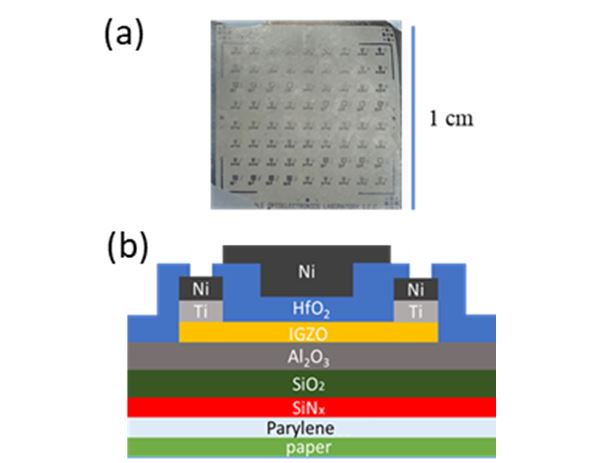
|
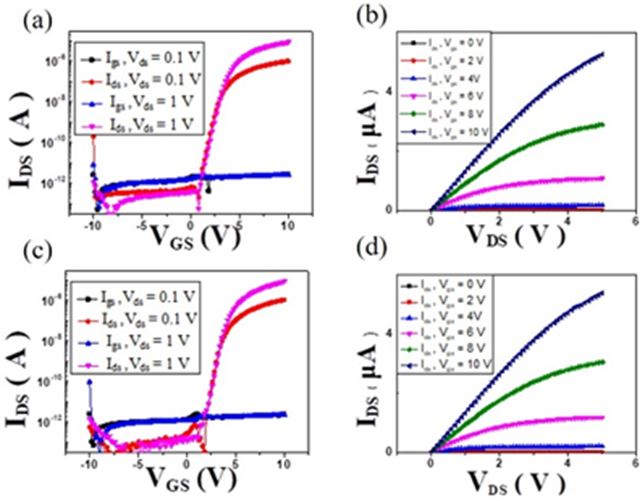
|
|
Fig. 1. (a) Optical micrograph and (b) schematic diagram of a-IGZO TFT on a cellulose nanopaper.
|
Fig. 2. I-V characteristics of a-IGZO TFT on cellulose nanopaper substrate (a)(b) before and (c)(d) after detachment from the carrier substrates.
|
Dual-Axis Mirror Scanner Fabricated with 3D Printing
Professor Jui-che Tsai
Graduate Institute of Photonics and Optoelectronics, National Taiwan University
台湾大学光电所 蔡睿哲教授
We have demonstrated a low-cost dual-axis mirror scanner of an X-shape architecture. The main structure is 3D-printed with PLA (polylactic acid) as the material. A 20 mm
´
20 mm aluminum-coated silicon chip is attached on the top of the 3D-printed piece and functions as the mirror. Miniature permanent magnets are installed on the back of the mirror, and the mirror can then be actuated by electromagnets. This X-shape scanner reaches 12.2 and 4.6 degrees (optical) for the x- and y-scans at the corresponding resonant frequencies (103 Hz and 128 Hz), respectively.
|
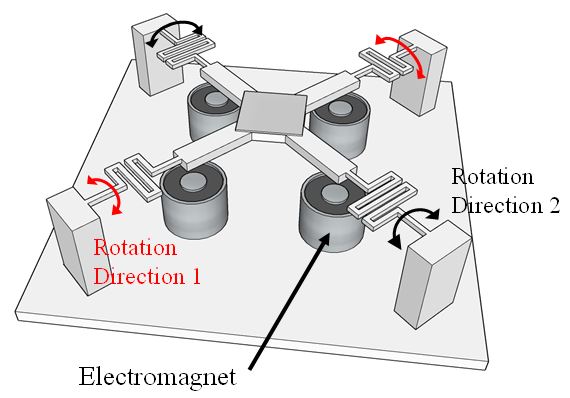
|
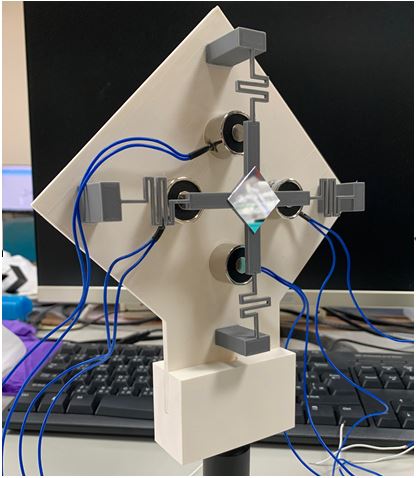
|
|
(a)
|
(b)
|
|
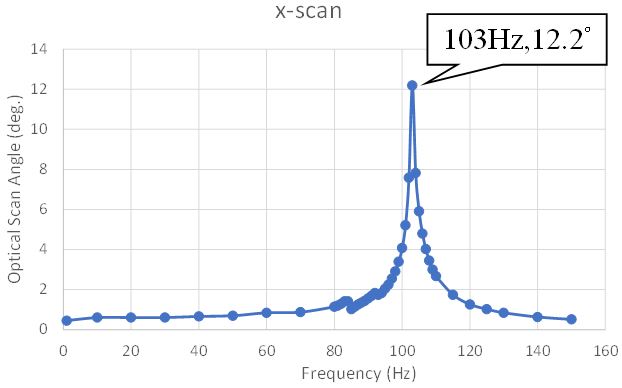
|
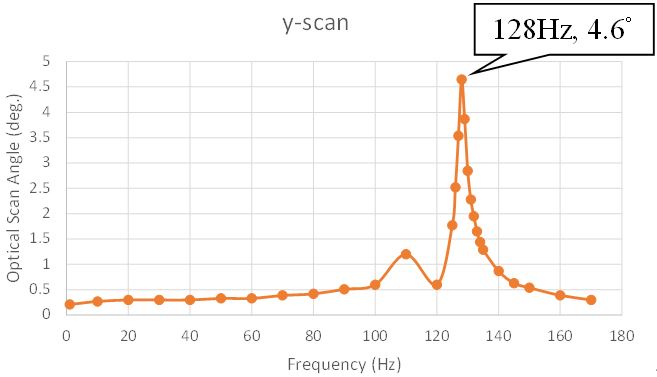
|
|
(c)
|
(d)
|
|
(a) Schematic drawing and (b) photo of the 3D-printed X-shape scanner; frequency responses (optical scan angle vs. driving frequency) of (c) x-direction scanning and (d) y-direction scanning.
|
© SPIE
Yi-Wen Cheng, Wei-An Tsui, Pin-Hung Yeh, Ching-Kai Shen, Jui-che Tsai, “Dual-axis mirror scanners fabricated with 3D printing,” Proc. SPIE 12669, Optomechanical Engineering 2023, 1266905 (28 September 2023)
|
|
|
|

|
|

|
|
| |
|
|

|
|
论文题目:Design and Fabrication of Ultra-High Sensitivity Thermal Sensing Devices Using Light-Emitting Transistors for Smart Technologies
姓名:Mukul Kumar 指导教授:吴肇欣教授
|
摘要
|
|
This dissertation presents a comprehensive study on the design, fabrication, and optimization of Light-Emitting Transistors (LETs) as advanced devices for next-generation smart thermal sensing technologies. LETs, based on III-V compound semiconductors, emerge as innovative, high-speed three-port devices integrating optical and electronic functionalities. Leveraging state-of-the-art quantum-well (QW) structures, LETs demonstrate exceptional potential for high-speed optical communication, enhanced performance in optoelectronic integrated circuits (OEICs), and advanced thermal sensing applications, particularly due to their thermionic emission properties. These findings position LETs as strong candidates for next-generation smart thermal sensing technologies, surpassing traditional thermal sensor technologies in thermal sensitivity.
The study begins with the design and fabrication of single-quantum-well heterojunction bipolar transistors (SQW-HBTs), designed to enhance thermal sensitivity. The innovative incorporation of a staircase QW into the base region of HBTs achieved a 72.23% increase in collector current across a temperature range of 25℃ to 85℃, attributed to faster electron escape dynamics from the QW. A modified charge-control model incorporating thermionic emission theory effectively explains this behavior and provides a foundation for optimizing SQW-HBT structures for thermal sensing applications.
Building on these initial results, the research advances to multi-quantum-well (MQW) and triple-quantum-well (TQW) HBTs to further improve thermal sensitivity. A newly modified charge-control model for MQW-HBTs is developed to account for the influence of quantum-well parameters, such as number and position, on the current gain. This model, validated against experimental results, guides the design of TQW-HBTs, which exhibit a remarkable 200% increase in collector current over the same temperature range and achieving a current sensitivity of 7 μA/℃. These findings highlight the potential of MQW-HBTs such as TQW-HBTs for applications requiring ultra-high thermal sensitivity.
To address the challenges of reduced current due to electron trapping in MQWs, the dissertation introduces a groundbreaking idea developed in the optoelectronics thermal technology by successful design and fabrication of the world’s first Darlington transistor configuration cascaded with LETs. This innovative approach combines the thermionic emission properties of LETs with the amplification benefits of the Darlington design, achieving a 153% increase in LET collector current from 25℃ to 85℃ and a further enhancement to 210% in the Darlington configuration. The collector current-to-temperature sensitivity improves from 8.53 μA/℃ in LETs to 26.2 μA/℃ in the Darlington configuration, with a voltage-to-temperature sensitivity reaching 9.12 mV/℃ surpassing conventional thermal sensor. Despite these advancements, challenges in achieving linear voltage-to-temperature responses are addressed, with recommendations for optimizing QW structures to balance sensitivity and linearity.
Further investigations into the effect of QW width reveal critical trade-offs between thermal sensitivity and linearity. Narrower QWs exhibit higher sensitivity, while wider QWs improve linearity. An optimal QW width of 90 Å achieves a thermal sensitivity of 1.34 mA/℃ at 100°C while maintaining excellent linearity, providing essential insights for designing high-performance thermal sensors. Finally, this dissertation work highlights the transformative potential of LET-based devices, including SQW-HBTs, MQW-HBTs, and TQW-HBTs, for smart thermal sensing applications. The novel configurations, such as the Darlington transistor cascaded with Light-emitting transistor, reported ultra-high thermal sensitivity in this studied. These advancements lay strong ultra-high-thermal performance front-end components for next-generation for smart thermal sensing technologies.
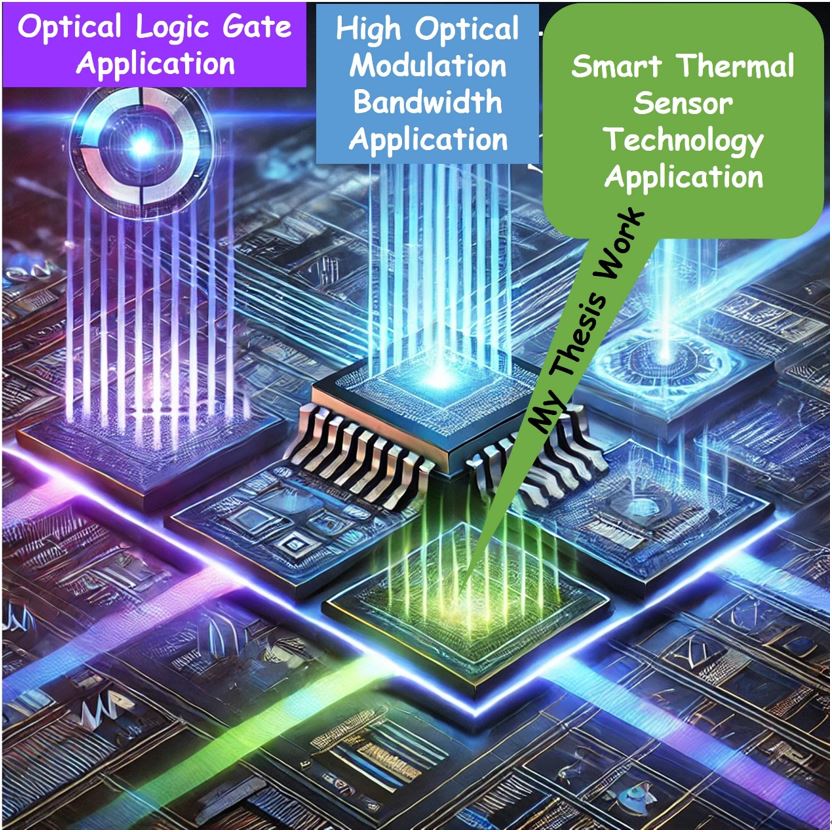 |
|
Fig. 1. Current applications of light-emitting transistors (LETs) and transistor lasers (TLs) include 1) optical logic gates, 2) high optical modulation bandwidth, and 3) smart thermal sensor applications (my thesis work). LETs and TLs are potential candidates for the development of optoelectronic integrated circuits (OEICs).
|
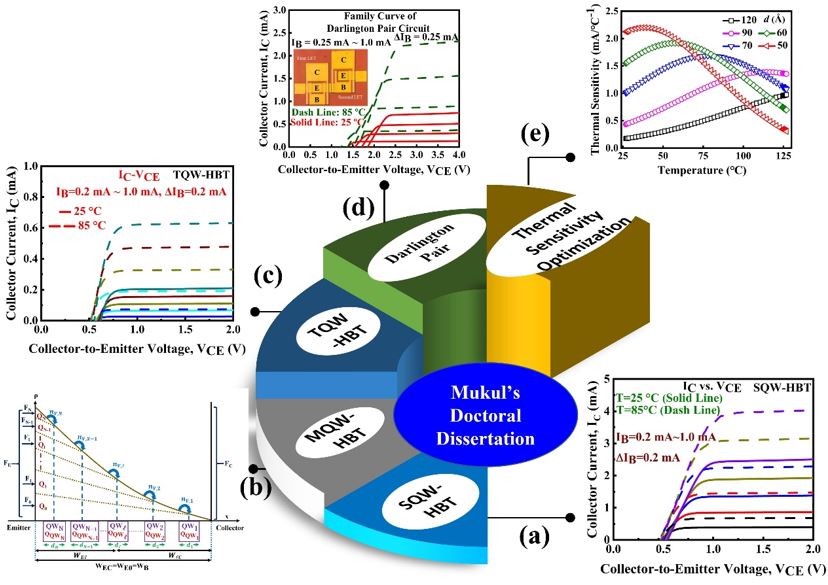 |
|
Fig. 2. (a): IC vs. VCE of n-p-n InGaP/GaAs SQW-HBT at different substrate temperatures. (b) Schematic of minority carrier distribution (ρ) in the base region of an MQW-HBT. (c) IC vs. VCE of n-p-n TQW-HBT at varied IB (0.2 mA to 1 mA), measured at Text=25 ℃ (solid line) and Text=85 ℃ (dashed line). (d) IC vs. VCE at different IB (0.25 mA to 1 mA) at various substrate temperatures. The inset shows the Darlington transistor device contacts and applied bias configuration, with 500 Ω resistance (R) connecting C2 to VDD. (e) Collector current derivation as a function of temperature for varying QW-widths (50 Å, 60 Å, 70 Å, 90 Å, and 120 Å).
|
|
|
|

|
|

|
|
| |
|
|

|
|
— 资料提供:影像显示科技知识平台 (DTKP, Display Technology Knowledge Platform) —
— 整理:林晃岩教授、郭权锋 —
磁光增强内存运算
非可逆磁光内存实现了积体光子平台,支持强大的矩阵向量乘法运算和快速、高效、无疲劳的程序设计能力。
根据国际能源总署(International Energy Agency)的数据,人工智能计算预计每年将达到460 TWh,到2025年将占全球电力消耗总量的5%左右。矩阵向量乘法(Matrix-vector multiplication, MVM)运算特别耗能,通常占AI运算期间消耗的总能量的很大一部分。例如,在GPU上运行的深度学习模型中,MVM操作在训练和推理期间会消耗约50-80%的总能量。内存运算与传感器运算透过实体运算实现了MVM操作的加速。创新硬件物理对于实现MVM操作的高能源效率至关重要。
光子内存具有功耗低、运算速度快、平行性高等特性;然而,其受到低积体化密度的限制。此外,实现光学负权重需要一对储存装置或一个额外的电开关,而突触权重由本质上为正的传输值表示。磁性内存具有超低功耗、优异的循环耐久性和非可逆特性;然而,它的开/关比较低,且多层级状态有限。
Paolo Pintus、Nathan Youngblood及其同事在《自然光电学》杂志上发表文章,报导了一种具有非可逆性的磁光储存单元,可用于光子内存计算。研究人员来自加州大学圣塔芭芭拉分校、卡利亚里大学、匹兹堡大学、日本国家先进工业科学技术研究所(National Institute of Advanced Industrial Science and Technology, AIST)和东京工业大学,他们制作了一个带有磁光层的硅基环形共振器(silicon micro-ring resonator, SMRR)平台。透过电流脉冲切换整合金电磁铁的磁化方向和幅度,然后改变每个共振器的波长相关传输,可以调制铁磁性薄膜(Ferromagnetic thin-film, CoFeB)的非挥发性状态。由于高速磁光响应,芯片上光学处理平台表现出快速(1 ns)、高效能(每单位位操作143 fJ)和强大(24亿次程序设计周期)的可程序性。透过差分操作,非可逆储存单元已实现了多层储存,其最大消光比(Extinction Ratio, ER)为16.2 dB(高于MRAM中通常实现的开/关比),从而进一步增强了计算应用中的抗噪声能力。
Pintus及其同事在SMRR上制作了积体化磁光材料铈(Cerium)取代钇铁石榴石(Yttrium iron garnet, Ce:YIG),以实现非可逆磁光。在一个MRR中,来自非可逆光学内存的差分传输提供MVM操作Wx = b,其中x是编码在输入光讯号功率中的输入数据,W是编码在相反传递模态的差分传输中的固定光学权重,而b是透过测量差分光强实现的乘法输出。光学非可逆性是指光学系统中时间反转对称性的破坏,导致两束非偏振光束沿相同路径以相反方向传递时表现出不同的传输特性的现象。磁光材料固有的光学非可逆性确保同一共振腔中的两种反向传递模态具有相反符号的分裂共振相移,导致一个微环形中顺时针(Clockwise, CW)和逆时针(Counterclockwise, CCW)传递模式的传输功率不同(图1a)。由于CW和CCW模式的传输都具有非可逆性,平衡光电探测器测量的差分讯号可实现高度对称的正负光学权重(图1b),这对于机器学习应用中的高精度至关重要。磁光共振器不仅透过高对称非可逆相移实现正负光学权重,而且与相互塞取MRR相比,其结构得到简化。
|
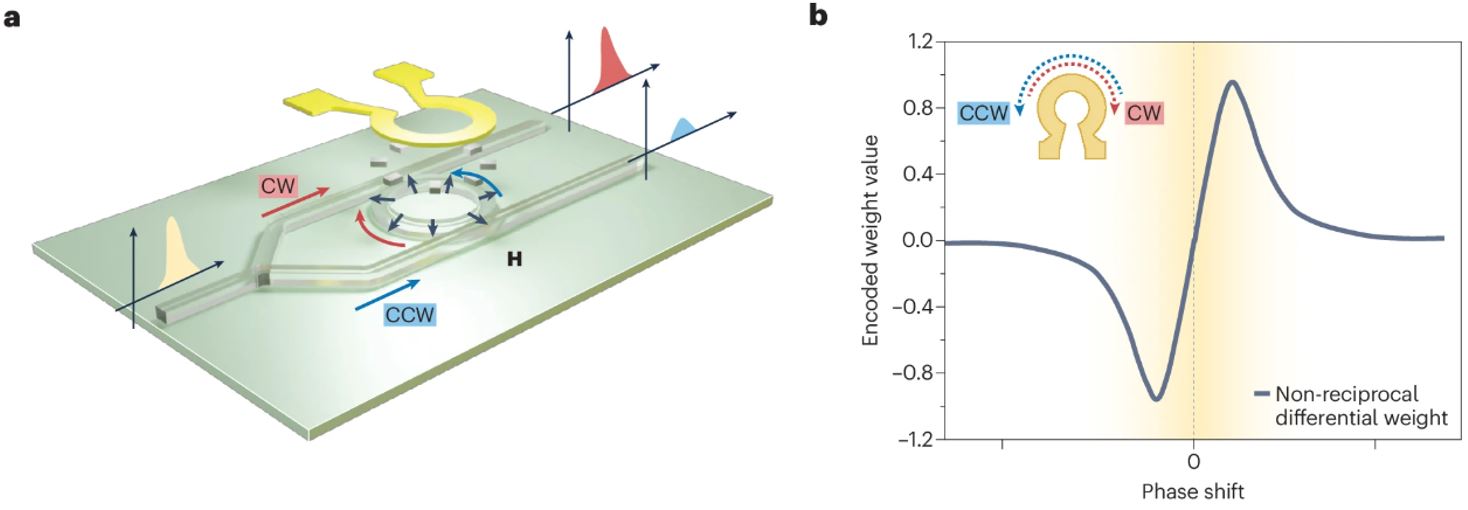
|
|
图1. a、在非挥发性磁场H下,由于磁光效应,SMRR中CW(顺时针)和CCW(逆时针)传递模态的差分传输。b、透过对CW和CCW模式下的直通连接埠传输进行差分运算,对非可逆储存单元的编码权重值进行归一化。
|
在图2中,展示了非可逆储存单元与可切换铁磁层整合时的非挥发性响应。在这个实验中,图案化的CoFeB磁条被整合在SMRR上方的包层中,以提供可程序、非挥发性的磁场。微米级CoFeB条形磁铁的形状各向异性和方向提供了在储存单元(24 Memory cell24)中引起非相互光学相移所需的静态径向磁场。在本次演示中,SMRR的横截面为1,000 nm × 220 nm,半径为50 µm。设备的测量装置和横截面如图2a所示。为了对储存单元的状态进行编程,需要将电流施加到整合电磁铁上,以对CoFeB磁畴中的磁场强度进行编码。移除电流后,扫描激光以获得CW模式的非挥发性MRR光谱偏移(图2c-e)。对于位于MRR谐振凹陷处的光学探头(图2c、d中的虚线),我们观察到图2b所示的光学传输中的滞后行为。当编程电流从负值增加到正值时,我们观察到电流大于0 mA时光传输的增加(图2b中的红点)。由于CoFeB磁层的饱和,传输最终会在200 mA以上达到饱和并保持恒定(请参阅图2a中的图示)。当我们将施加电流的方向从正值变为负值时,传输保持恒定直到负电流值,突出了储存单元的非挥发性响应。图5b的结果显示,至少有11个不同的光传输级别,对应于能够储存~3.5位的非挥发性储存单元;但是,这个值受到我们的实验设定而不是设备本身的限制。
|
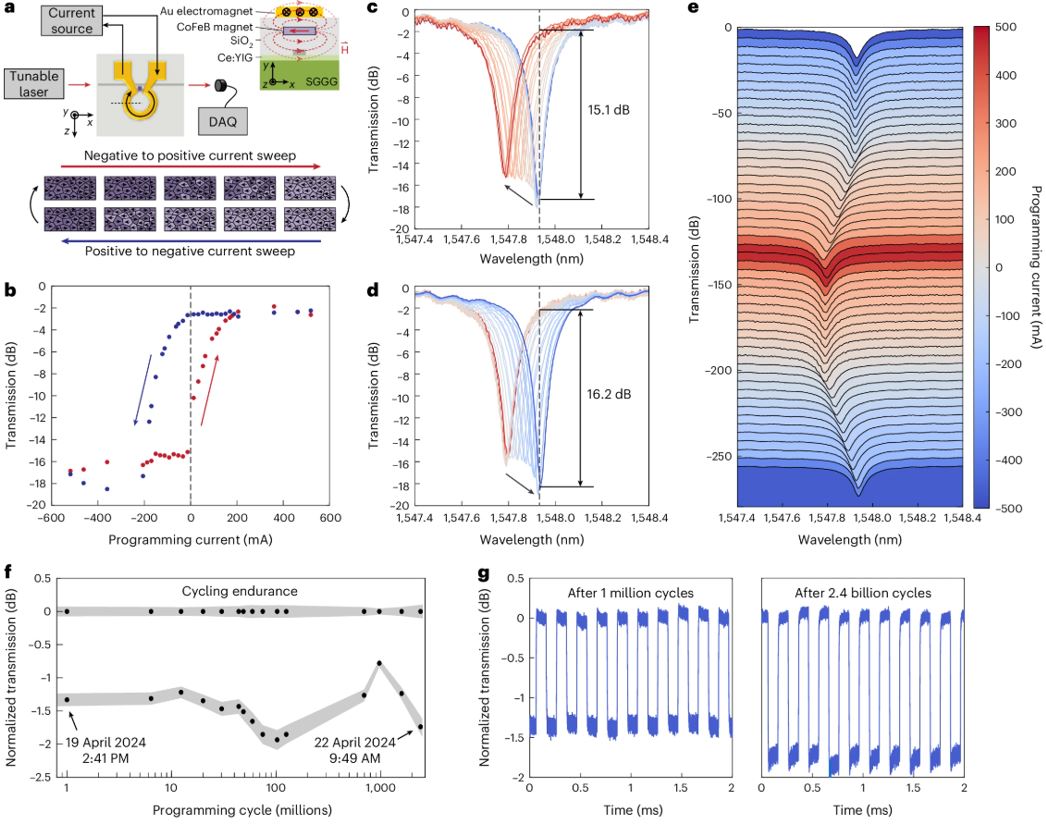
|
|
图2. a、非挥发性权重编码的实验装置。来自金电磁铁的磁场根据施加电流的幅度和极性使CoFeB铁磁层的磁畴排列。b、芯片上整合CoFeB条形磁体的非可逆储存单元的光传输磁滞。对于这些传输测量,侦测波长是固定的(c和d中的黑色虚线)。c、从负到正的编程电流扫描显示正电流出现蓝移。d、从正到负的电流扫描显示回到原始共振位置。e,顺序编程电流的透射光谱瀑布图,首先沿正方向扫描,然后沿负方向扫描。f、经证实具有超过24亿次写入和擦除循环的耐久性。非挥发性写入和抹写循环(Erase cycles)的平均值显示为黑色数据点,而灰色带表示标准差。g中的时间域测量显示了储存单元的运行,没有观察到任何效能下降。观察到的消光比的变化归因于三天测量中未封装设备的热漂移。
|
异质整合磁光于SMRR上使得光学平台与外围控制电路的整合成为可能,加速了芯片上光子内存计算方法的硬件实现。然而,要实现更有效的运算性能还需要进一步发展,这需要改进硅光子整合技术。特别是在内存运算的背景下,将整个神经网络完全映像到仿真权重库所需的大量参数,需要整合多层级状态的储存单元和较高的整体整合密度。晶圆接合(Wafer bonding)制程必须考虑制程的兼容性,这可能会限制某些高性能功能材料的使用。在高整合密度的芯片中,磁光内存、硅波导等对应功能组件的对准形成了巨大的挑战。此外,透过非晶硅的生长和图案化来制造波导等功能组件可以降低SMRR的消光比,从而减少储存单元中可用的多层级权重状态的数量。因此,在保持计算性能的关键参数(例如磁光系统中的开/关比和位精度)的同时,改进制造和整合制程至关重要。
在功能方面,大多数光子内存计算演示都集中于输出透射光功率,它是透过将固定波长的输入光向量与由波长相关的透射共振器单元构成的矩阵相乘而得出的。然而,光向量包含多维信息(空间、时间、偏振、光谱等),可进一步用于光子运算。在多维MVM计算中,空间、时间、偏振和波长维度上的强度分布形成输入向量,而依赖这些维度的传输特性则作为光学权重。多维光学处理将使更多的光学信息在获取后能够在感测终端附近同时处理。这种方法增强了光信息处理的平行性,进一步提高了边缘运算的整体处理能力。内存多维光子运算可以满足行动装置、智能交通、娱乐、安全、工业制造以及医疗和科学系统中各种潜在应用的需求。为了实现多维光学处理,必须开发能够根据多维信息编码权重的可靠光学功能单元。此外,这些光子储存单元和光互连的高密度整合将是直接多维视觉信息处理的重要步骤。
|
参考资料: |
Ma, Sijie, Bangsen Ouyang, and Yang Chai, "Magneto-optics enhances in-memory computing," Nature Photonics 19.1 (2025): 9-10.
https://doi.org/10.1038/s41566-024-01599-5
DOI:10.1038/s41566-024-01599-5
|
|
参考文献: |
Pintus, Paolo, et al, "Integrated non-reciprocal magneto-optics with ultra-high endurance for photonic in-memory computing," Nature Photonics (2024): 1-9.
https://doi.org/10.1038/s41566-024-01549-1
DOI:10.1038/s41566-024-01549-1
|
|
|
|
|

|
|

|
|
|
|
 |
|
 |
|
|
|
|